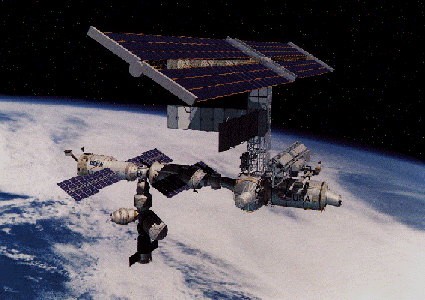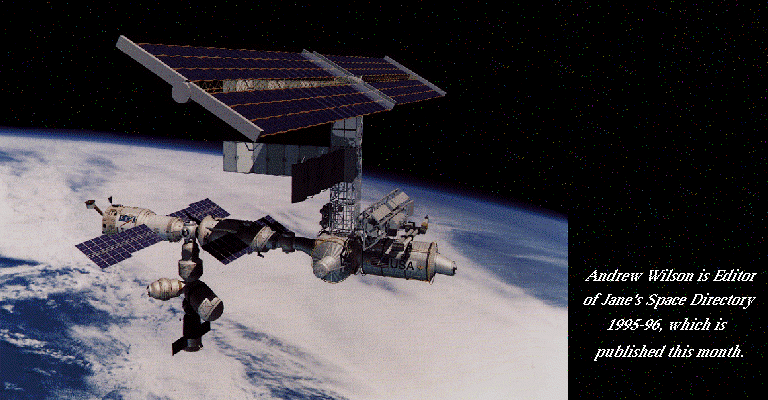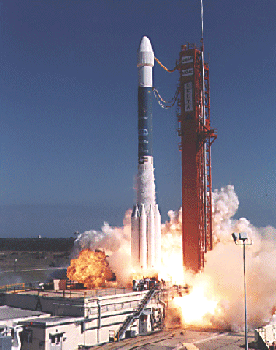

It has long been recognized that US launch capability is out of date, inefficient and expensive. Numerous studies have recommended radical programmes, including the NLS National Launch System, the Air Force's Spacelifter and the more exotic single stage to orbit (SSTO) plans of the National AeroSpace Plane and Delta Clipper.
The Space Transportation Policy signed by President Clinton last year has set the pattern for US launch vehicle development well into the next century. It gave the DoD responsibility for upgrading existing medium and heavy expendable launch vehicles (ELVs), and NASA the role of developing a reusable next generation after 2000. The DoD is expected to select one current ELV in late 1997 to form the basis of the Evolved ELV (EELV) family to replace Delta, Atlas and Titan. The $2 billion RDT&E programme includes two medium (MLV) and one heavy (HLV) version launches in 2000 and 2003, respectively, for operations to begin in 2001 and 2005.
It is expected the family will need to accommodate 17 to 20 launches annually. Military specifications have been dropped and the goal is to reduce launch processing time to 30 days.
In January NASA invited industry to submit designs for two reusable launch vehicles. The X-33 will test the feasibility of replacing the Shuttle and most of the USA's ELVs by 2012 with a reusable launch vehicle (RLV). The decision to build the X-33 is planned for July next year; the RLV would cost $5-15 billion. Industry is required to invest comparable sums in partnership with NASA; the RLV would ideally be privately funded, with the government guaranteeing to buy a certain level of launches. The smaller X-34 will serve as an 1140 kg satellite launcher, with a first orbital launch in 1998. The Orbital Sciences Corp/Rockwell team will invest $100 million in addition to NASA's $70 million through FY99. The 2-stage liquid propellant vehicle will be air-launched and the reusable stage 1 will return to a conventional runway. The X-34 will also demonstrate RLV technologies, including advanced thermal protection, all-composite structures, reusable cryogenic tanks and state-of-the-art avionics.
Commercial remote sensing has been growing steadily. The US Department of Commerce estimated last year that the $400 million annual market for remote sensing data will grow to $2 billion by 2000, paralleling the development of user software packages.
In 1993 the CIA acknowledged that it was considering releasing its archived imagery; President Clinton signed the executive order in March this year and the public will be given access within 18 months at the National Archives to more than 800,000 images from reconnaissance satellites flown between 1960 and 1972. This is only a foretaste of the deluge of space imagery that will appear in the next few years.
The first privately funded operated US remote sensing satellite was initiated in 1991 with a NASA contract to provide daily ocean imaging. Orbital Sciences Corp's SeaStar will provide colour data to NASA for five years from 1996. OSC also plans its own OrbView 1 m resolution image system; Lockheed Martin and GDE Systems propose their own separate 1 m system.
The first private commercial system licensed by the Department of Commerce (DoC) is EarthWatch's system offering 3 m resolution from mid-1996. The military's exclusive right to high resolution imagery was removed in March last year down to at least 1 m by the Clinton Administration. The DoC, as licensing agency, retains the power to order shut down in times of crisis.
The impetus has come from US companies looking for new sources of revenue, and from Russian sales of digitized film imagery down to 2 m from both civil and military missions. Some Russian material has been available for several years, for example through Soyuzkarta, but its use has been hampered by a rigid and unresponsive system. Sovinformsputnik is licensed to sell data from some film cameras of military satellites. The KVR-1000 and TK-350, for example, fly on the fourth generation Yantar/Kometa spy platforms. Likewise, Priroda established the WorldMap consortium with the UK's JEBCO Information Services to sell digitized versions of its Resurs-F imagery. Its archives, holding two million negatives, are being digitized and added to a database to facilitate user searches. Both organizations can provide 2 m resolution (and greater if allowed), exceeding Western commercial capability. Priroda expects to begin distributing current digital 3 m resolution panchromatic imagery this year.
The wide availability of high resolution and timely imagery cannot be ignored by any segment of the remote sensing field hoping to remain competitive. French industry is pushing its government to relax the 5 m resolution rule that allows only military observation satellites to return finer imagery. Spot 4 will still be limited to 5 m. The French Government would permit the sale of a military system to a friendly country, but requires the capability to turn it off when desired.
India expects to launch 10 more remote sensing satellites by 2005. The commercial EOSAT of the USA and the Indian Government signed an agreement in February for exclusive worldwide marketing rights. EOSAT expects that, by mid-2001, the majority of its new imagery will be from Indian satellites.
The same pressures that are expanding the commercial sector are forcing the rationalization of US Government systems. The plan to combine the military DMSP and civil NOAA polar meteorological satellite systems is finally underway, aiming to reduce the number of operational satellites from four to two. The first joint satellite is expected in 2005, controlled by NOAA; the DoD will close its own stations, but retain one as backup. A $300 million saving through 1999 is expected, and then at least $1 billion over the next 15 years.
The US Navstar Global Positioning System (GPS) is providing the basis for a rapidly growing market in commercial navigation receiver systems and applications. GPS applications are one of the space age's most important and impressive spin-offs. The system achieved full Block 2/2A strength for the first time (24 satellites, including three hot spares) last year, providing global 16 m accuracy for military users and less than 100 m for civil. Civil users are guaranteed free access for 10 years from this year. The US Department of Transportation formally became part of the GPS management system last year to accommodate civil interests. The DoD is thus officially operating the system in part for the civil community and must ensure that further testing and development has minimum impact on those users.
The worldwide GPS receiver market is worth about $1.27 billion, but the US GPS Industry Council projects that will explode to $8.5 billion in 2000. Aviation applications, which now receive high visibility, will comprise only 4.5 per cent of the total market for GPS products by 2000. The major growth will be in commercial and consumer markets. Applications such as car navigation, integration into cellular phones and outdoor recreation will account for over 60 per cent. Survey and mapping will rise by six times.
However, there is no escaping the fact that GPS is a US military system. There is no guarantee that it will continue to be operated ad infinitum for the benefit of civil users. European interests are naturally cautious and would like a purely civil constellation.
Inmarsat is known primarily for its maritime and, now, overall mobile communications, but its constitution also covers the provision of navigation services, and could lead to a global civil system. Inmarsat 3's transponder is the first step, augmenting GPS with ground-derived integrity information, additional ranging signals and wide-area differential corrections.
The Inmarsat 4 GEO series, expected to appear early next century, could include the more capable Navigation Lightsat Payload. It would be simpler than the GPS satellite payload as it would not have to conform to military standards for radiation hardening or encrypted coding. The Inmarsat 3 integrity monitoring network would allow a reduction in clock stability and data storage. The next step would add these payloads to intermediate orbit satellites. Fifteen of these teamed with six to eight GEO satellites could give a 2D service if GPS is removed. A full civil system would require another 15 dedicated satellites in intermediate paths.



 Return To Space Menu.
Return To Space Menu.